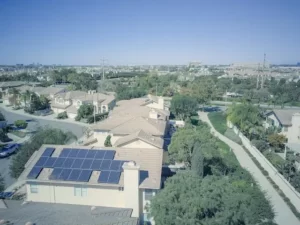Just as Achilles had his heel, solar cells too have their vulnerabilities that can impact their heroic efforts in harnessing the sun’s power. You’re likely familiar with the promise of solar energy as a clean, abundant power source, but you might not be aware of the intricate factors that play a crucial role in the performance of solar cells.
From the intensity of sunlight bathing the cells to the angle at which the rays kiss their surfaces, each element can bolster or diminish their efficiency. You’ve probably considered how the warmth of a sunny day feels on your skin, but have you thought about how temperature variations might affect the output of these silent energy converters? And let’s not forget the materials from which they’re made or the way they’re installed each aspect can be a make-or-break factor in the quest for energy efficiency.
While the cells may appear static and unchanging, they, like all things, age, and their ability to capture sunlight wanes with time and environmental exposure. As we explore these factors further, you’ll uncover the complexities that dictate just how effective your solar panels can be.
Listen To The Summary
Sunlight Intensity Impact
The power output of your solar cells can vary significantly with the amount of sunlight they receive, making sunlight intensity a crucial factor in their performance. If you’re looking to serve your community by installing solar panels, understanding sunlight intensity is key.
Solar cells convert sunlight directly into electricity, but their efficiency dips when the sun plays hide and seek with clouds. Cloud cover can drastically reduce the intensity of sunlight hitting your panels, leading to lower energy production.
Throughout the day, you’ll notice that electricity generation fluctuates; this is due to diurnal variation, which refers to the changes in sunlight intensity as the sun travels across the sky. In the morning and late afternoon, your panels won’t catch as much sun as they’d around noon when the sun is at its peak position.
To optimize the benefits of solar power for your community, you’ll want to consider the patterns of both cloud cover and diurnal variation. By accounting for these variables, you can better estimate the energy yield and effectively plan for energy storage or supplemental power sources to ensure that you’re always able to serve those around you with a steady supply of clean energy.
Incidence Angle and Performance
Your solar panel’s energy conversion efficiency isn’t just about how much sun it gets; it’s also influenced by the angle at which sunlight strikes the surface, known as the incidence angle. When the sun’s rays hit the panels directly, that’s when you get the most power. But as the angle changes, several things happen that you should be aware of:
- Shading issues: If the angle isn’t optimal, parts of the panel can cast shadows on others, reducing the overall output. It’s like when you’re helping someone; if you’re not in the right position, you might cast a shadow rather than light.
- The angle of incidence: A steeper angle of the sun’s rays can lead to a decrease in energy absorption. Imagine holding a flashlight against a wall; the best illumination comes from a direct angle.
- Spectral variations: The sun’s spectrum can change based on the angle, affecting how much energy your panels can harvest.
It’s vital to adjust the tilt of your solar panels throughout the year to match the sun’s path, just as you’d adjust your approach to help someone effectively. This ensures maximum exposure and aids in overcoming potential shading issues and spectral variations.

Temperature Effects on Efficiency
Just as extreme weather can throw a wrench in your outdoor plans, high temperatures can significantly hinder the efficiency of solar cells. You might think that more sun means more energy, but solar panels have an optimal temperature range, and when they get too hot, their efficiency can decrease. Here’s why: as the temperature rises, the semiconductor materials within the solar cells become more agitated, leading to increased energy loss through heat rather than conversion to electricity.
Shading issues play a critical role here. While it may seem counterintuitive, strategic shading can help in maintaining the temperature of the solar panels, preventing them from overheating and thus sustaining their efficiency. However, it’s a delicate balance – too much shading and you could block the sunlight that’s needed for energy production.
Conductivity variations are another factor to consider. Different materials change their electrical properties at different rates with temperature changes. As a result, the solar cell’s ability to efficiently conduct electricity can vary with the temperature, leading to a potential drop in performance during hot spells.
Material and Installation Factors
When selecting materials and planning installation for solar cells, you’re not just choosing the bones of your system but the heart of its performance potential. It’s vital to pick the right components and install them correctly to ensure the most efficient energy production for the communities you serve.
The materials you choose can significantly influence how well your solar cells convert sunlight into electricity. For instance, the type of conductive coatings applied to the solar cells can affect their ability to capture light and convert it into usable power. These coatings are crucial for maximizing the conductivity and, consequently, the overall efficiency of the solar panel.
Moreover, how you install the solar panels can be just as important as the materials you choose. Here are a few key considerations:
- Orientation and Tilt: Properly angling the solar panels maximizes exposure to sunlight throughout the year.
- Shade Analysis: It’s essential to assess the installation site for potential shading from trees, buildings, or other obstructions that could reduce performance.
- Ventilation: Adequate airflow around the panels prevents overheating, which can lower efficiency.
Maintenance and Aging Considerations
While selecting top-notch materials and ensuring proper installation sets the stage for optimal solar cell performance, it’s the ongoing maintenance and understanding of aging effects that truly sustain their energy output over time.
You see, just like any other piece of equipment, solar cells can’t escape the wear and tear that comes with the passing years. It’s your role to keep them in their best shape, not just for efficiency, but to serve the community with reliable, clean energy.
Regular cleaning is crucial; dirt accumulation can significantly hinder sunlight absorption, leading to a drop in power production. Imagine layers of dust acting like a curtain, blocking the sun’s rays from reaching the stage. You wouldn’t want that, would you? Therefore, ensure that solar panels are kept clean and free of debris.

Then there’s the issue of corrosion risks. With time, exposure to the elements can lead to wear on the solar cells and their components. You’ll need to watch out for signs of corrosion and address them promptly to prevent further damage. It’s about being proactive, not reactive.
Staying ahead of maintenance and recognizing the natural aging of your solar cells will help you provide a consistent, sustainable service for years to come.
Frequently Asked Questions
How Does the Color of the Surface Underneath the Solar Panels Affect Their Performance?
The colour beneath your panels matters because surface reflectivity can influence efficiency. Lighter colours boost performance by reflecting more light. It’s about harnessing colour psychology to maximize the benefit for others.
Can the Use of Solar Concentrators or Mirrors Enhance Solar Cell Efficiency, and How Are They Implemented?
Yes, using solar concentrators or mirrors can boost your cell’s efficiency. Proper mirror alignment minimizes optical losses, ensuring more sunlight hits the panels. This tech serves communities by maximizing renewable energy capture.
How Do Local Weather Patterns, Such as Frequent Fog or Dust Storms, Impact Long-Term Solar Cell Performance?
Local weather, like frequent fog or dust, can hinder your solar cell’s output. Cloud coverage and temperature variations also play a role, potentially reducing efficiency and affecting their long-term energy contribution.
What Is the Impact of Electromagnetic Interference From Nearby Equipment on Solar Cell Performance?
Electromagnetic interference from nearby devices can disrupt your solar cells. To protect them, consider material shielding and regular interference testing, ensuring optimal function to better serve your community’s energy needs.
Can Solar Cells Be Recycled at the End of Their Lifespan, and What Is the Environmental Impact of Their Disposal?
You can recycle solar cells after their material lifespan ends. Proper disposal methods reduce environmental harm, serving our planet by minimizing waste and conserving resources for future generations. Always choose eco-friendly options!
Conclusion
In conclusion, your solar cell’s performance hinges on several factors. The sun’s intensity, the angle of light hitting the panels, and the ambient temperature all play a role.
The quality of materials and the precision of installation can’t be overlooked, and over time, maintenance and aging will affect output.
Keep these in mind to ensure your solar investment continues to pay off, harnessing clean energy efficiently for years to come.



